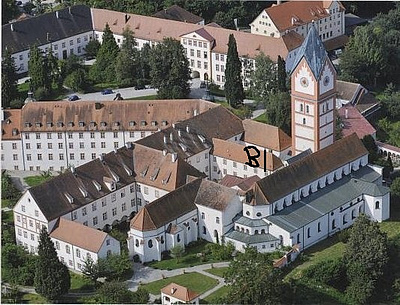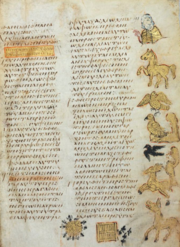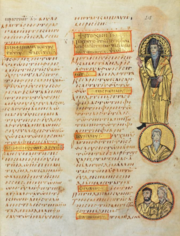Short Chronicle of the Edition of the Writings of John of Damascus
When in 1969 P. Bonifatius Kotter, Monk in the Upper Bavarian Benedictine Monastery of Scheyern (about 50 km north of Munich) presented the first of altogether five volumes of the Edition of the Writings of John of Damascus attended to by him, the project already had an eventful history of 30 years.
The humanistic Progymnasium, graduating students after tenth grade, was part of Scheyern Abbey since the 19th century. The National Socialist government had reduced its range of teaching already in 1938 only to shut it down completely in 1940. Because of the school’s closing, three of the philologists teaching at the school had to look for new professional challenges:

- P. Hildebrand Beck (1910–1999, after leaving the convent in 1944 named again Hans-Georg Beck, 1960–1975 Professor of Byzantine Studies at LMU Munich),
- P. Albert Siegmund (1908–1979) and
- P. Johannes M. Hoeck (1902–1995).
In 1939, the convent’s plenary assembly therefore decided to intensify its focus on promoting Eastern Church studies. To this end the Scheyern Abbey Byzantine Institute was founded.
The Early Years
Albert Ehrhard (1862–1940), emeritus church historian at the Friedrich-Wilhelms-Universität Bonn und intimate connoisseur of Byzantine theological literature, advised the monks in Scheyern regarding a research focus. He suggested a critical edition of the prose writings of John of Damascus. Ehrhard’s untimely death basically deprived the just founded institute’s John Damascene research right at the beginning of one of three researchers.
P. Hildebrand Beck took over the revision of Ehrhard’s presentation of Byzantine theological literature, which had been published as part of K. Krumbacher’s History of Byzantine Literature (21897). Shortly thereafter he left the order. Still, the Byzantine Institute was able to build a considerable basis for the John of Damascus edition work to come during the last years of World War II and the first years of the post war era. This groundwork comprised the development of a special library with about 5000 volumes as well as the acquisition of about 15.000 manuscript pictures and extensive preliminary studies.
P. Johannes M. Hoeck directed his focus on the Greek manuscript tradition, while P. Albert Siegmund concentrated on the Latin tradition.
New external staff members could be recruited:
-
orientalist Georg Graf (1875–1955), pursuing the Arabic tradition and
-
historian und byzantinist Georg Stadtmüller (1909–1985), who researched the history of the reception of John of Damascus.
Post-War Period
Towards the end of World War II the Byzantine Institute finally recruited another albeit unintentional staff member for a short time: Franz Dölger (1891–1968), since 1931 Professor of Byzantine Studies at the LMU München and teacher of P. Johannes M. Hoeck, was dismissed from civil service in 1946 for the duration of a year and a half for reasons of unresolved questions regarding his proximity to the Nazi regime. Looking for new work, he received a warm welcome in Scheyern.[1]
Dölger supported the Scheyern John Damascene research by creating a word index of the unequivocal genuine writings and tried to clarify the authenticity of other works passed on under the name of John of Damascus, based on this statistical linguistic material. The results of this early phase in the Byzantine Institute were presented to the scientific public in two programmatic publications: In 1950, Franz Dölger published an article already written in 1948, Die Johannes-Damaskenos-Ausgabe des Byzantinischen Instituts Scheyern (Byzantion 20 [1950] 303–314). In 1951, P. Johannes M. Hoeck published the fundamental treatise Stand und Aufgaben der Damaskenos-Forschung (Orientalia Christiana Periodica 17 [1951] 5–60).
Editorial Work by P. Bonifatius Kotter

When P. Johannes M. Hoeck was elected Abbot of the Benedictine Abbey of Ettal in 1951, research at the Byzantine Institute of Scheyern almost came to a standstill again, since now the second Byzantinist from the original three-member staff had to quit. Since there was no other adequately trained philologist at hand who could have shouldered the editorial work still to come, follow-up training became the order of the day: Nearly at the age of 40, P. Bonifatius Kotter (1912–1987) was sent to Munich to take on Byzantine studies with Franz Dölger. After having been classified as so-called “Minderbelasteter” in a denazification tribunal, Dölger had been reinstalled to his University position in 1947.
Kotter received his doctorate from Dölger in 1956 with a thesis on the handwritten tradition of the script “Source of knowledge” (Πηγὴ γνώσεως). Back in Scheyern, for the next 30 years and until his death Kotter developed the first five volumes of the Schriften des Johannes von Damaskos. Except for the support of an assistant, he remained the only active staff member of the Byzantine Institute. Of course, P. Johannes M. Hoeck had returned to Scheyern as Abbot in 1961 and also took over the lead at the Byzantine Institute, but his Abbot duties did not allow him to participate in the daily work at the institute. It was also in 1961, when the John Damascene project was accepted into the program of the Patristic Commission of the West-German academies of Sciences and Humanities.
Integration into the Bavarian Academy of Sciences and Humanities
Since 1980, funding by the Academies' Programme in the Union of the German Academies of Sciences and Humanities has been secured. The accompanying integration into the Bavarian Academy of Sciences and Humanities was institutionalised in 1982, when the „Arbeitsstelle München der Patristischen Kommission der Akademien der Wissenschaften“ (Office of the Patristic Commission in the Academies of Sciences and Humanities) was founded. Until 2011, it was headed by Ernst Vogt (1930–2017), professor of Greek Philology at the LMU München.
From Kotter’s Death to Present
After almost 30 years of editorial work und publishing the first five volumes of the Writings of John of Damascus, P. Bonifatius Kotter died in 1987.[2] Since up to that point in time, the Abbey had not come up with junior scientists, new staff members for the editorial work had to be recruited from the outside. So Byzantinist Robert Volk joined the project the same year. He succeeded in continuing Kotter’s editorial work with the Greek Barlaam novel, passed on under the name of John of Damascus. Volk was able to publish the edition in 2006 and 2009 as volumes VI/1 und VI/2 of the Writings of John of Damascus. In 2013 followed by volume VII with the John of Damascus commentary on Paulus. Since then the Greek vitae on John of Damascus are being edited, supposed to be published as volume X.
Commission for Greek and Byzantine Studies
Rooms at the Byzantine Institute in Scheyern were still used for research until 2008. That year, new office space was created at the Bavarian Academy of Sciences and Humanities in the Munich Residenz. In 2011, Martin Hose, Professor of Greek Philology at the LMU München, took over the project lead, as part of of the newly founded Commission for Greek and Byzantine Studies (Kommission für gräzistische und byzantinistische Studien). The same year, a second staff member joined the project. Hellenist Tobias Thum has been editing volume VIII of the Writings of John of Damascus, the Sacra passed on under his name, in cooperation with José Declerck. Since 2012, Theologian and scholar of Arabic studies, Dipl. theol. Eva Ambros M.A., has been contributing to the project, developing the edition of John of Damascus’ Arabic vita, also to be published in volume X.
Literature
[1] Detailed information by M. Hose, Franz Dölger (1891–1968). Ein Leben für die byzantinische Diplomatik, in: D. Willoweit unter Mitarbeit von E. Latzin (Hrsg.), Denker, Forscher und Entdecker. Eine Geschichte der Bayerischen Akademie der Wissenschaften in historischen Portraits, München 2009, 305–321.
[2] Acknowledgement of his life’s work by E. Vogt as preface in: Die Schriften des Johannes von Damaskos, herausgegeben vom Byzantinischen Institut der Abtei Scheyern. V: Opera homiletica et hagiographica, besorgt von P. Bonifatius Kotter O.S.B., Berlin/New York 1987, V–VI.



